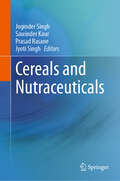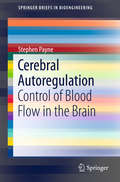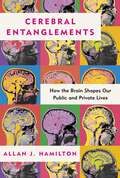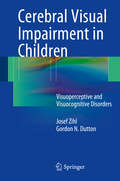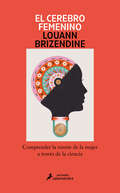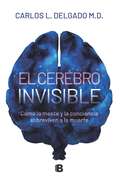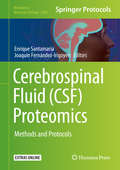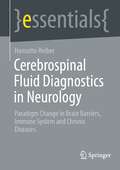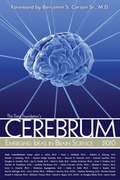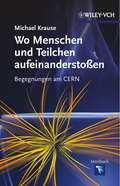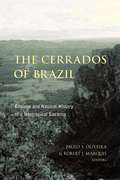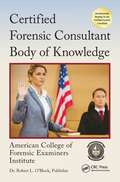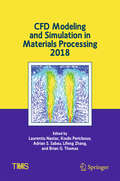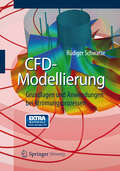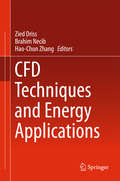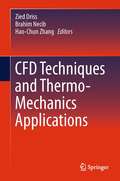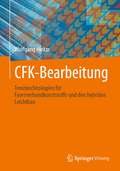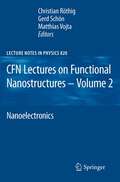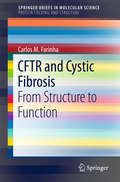- Table View
- List View
Cereals and Nutraceuticals
by Jyoti Singh Joginder Singh Sawinder Kaur Prasad RasaneThis book is focused on the production, cultivation, processing, composition, nutritional value, value addition, health implications, limitations and safety of nutricereals with an emphasis on their functional significance. With changing food habits and increasing health concerns, consumers around the world are opting for a more nutritious diet than that was consumed until recently. Nutricereals are now becoming a food of choice for many and newer products are being developed using them. Thus, a better understanding of these valuable crops is becoming essential. Researchers and scientists around the world have now turned their attention to nutricereals as a cheaper and most important solution to nutritional deficiencies. Processing of these cereals is matter of advanced research in recent times to make it suitable and palatable for human consumption and taste, and hence high emphasis is given on processing and value addition of these cereals. A comprehensive account of these important aspects is highly required. The book covers specific aspects of the nutricereals of consumption pattern and acceptance and the cultivation practices and health benefits associated with their consumption. Considerations on processing, value addition and safety associated with various nutricereals and current and future challenges and the opportunities for its utilization are highlighted in the book. This book forms an important resource on nutricereals for food technologists and food scientists.
Cerebral Autoregulation: Control of Blood Flow in the Brain (SpringerBriefs in Bioengineering)
by Stephen PayneThis Briefprovides a comprehensive introduction to the control of blood flow in thebrain. Beginning with the basic physiology of autoregulation, the author goeson to discuss measurement techniques, mathematical models, methods of analysis,and relevant clinical conditions, all within this single volume. The author drawstogether this disparate field, and lays the groundwork for future researchdirections. The textgives an up-to-date review of the state of the art in cerebral autoregulation,which is particularly relevant as cerebral autoregulation moves from thelaboratory to the bedside. CerebralAutoregulation will be useful to researchers in the physical sciences suchas mathematical biology, medical physics, and biomedical engineering whose workis concerned with the brain. Researchers in the medical sciences and cliniciansdealing with the brain and blood flow, as well as industry professionalsdeveloping techniques such as ultrasound, MRI, and CT will also find this Briefof interest.
Cerebral Cortex Development: Methods and Protocols (Methods in Molecular Biology #2794)
by Koh-Ichi NagataThis volume explores the latest developments in the study of the cerebral cortex. The chapters in this book cover a wide array or established methods such as in situ hybridization of brain slices; two-photon FRET/FLIM imaging of cerebral neurons; BioID analysis of actin-binding proteins; generation of iPS cells using Sendai Virus vectors; in vivo whole-cell recording from the mouse brain; and locomotor assays in Drosphila larvae and adult flies. Written in the highly successful Methods in Molecular Biology series format, chapters include introductions to their respective topics, lists of the necessary materials and reagents, step-by-step, readily reproducible laboratory protocols, and tips on troubleshooting and avoiding known pitfalls.Comprehensive and thorough, Cerebral Cortex Development: Methods and Protocols is a valuable resource that will help both expert and novice researchers further enhance their understanding of this important field.
Cerebral Entanglements: How the Brain Shapes Our Public and Private Lives
by Allan J. HamiltonA profound and profoundly important book that, using the most up-to-date revolutionary discoveries in neuroscience, shows us how to understand the brain; how it allows us to think, feel, experience and perceive, written by an acclaimed Harvard-trained neurosurgeon.It took a brain surgeon who&’s spent a lifetime in the operating room experiencing the brain's union of form and function to write this book. Cerebral Entanglements, unlike most books on the brain, looks at the intimate and vital emotions in our lives, and shows as well, how neuroimaging studies can transform our understanding of crucial emotional or mental health concerns. Why do we love? Why do we hate? Why do we kill? Why do we laugh? Why do we have faith? Why does time stand still or speed up? Focusing on the nature of consciousness, affection, trust, romance, empathy, kindness; prejudice, sadness, happiness, depression, grief, and the nature of laughter, the author shows us how neuroscience has changed our understanding of these emotions as he explores the extraordinary revelations that have emerged from brain imaging and functional studies. We see that we are the first generation to perceive the contours of a human thought, track the course of an emotion, even watch memory come together. Allan Hamilton writes clearly and accessibly, about the complex science driving our emotions and experiences, and shows how our newfound knowledge can impact our well-being, individually and as a society. As the book explores the nature of happiness, laughter, stress, PTSD. Hamilton writes about how the brain perceives and experiences music, memory, and time itself.
Cerebral Laterality: Theory and Research
by Frederick L. KitterleResearch on clinical populations and studies of normal individuals support the conclusion that there are functional differences between the cerebral hemispheres. This book captures some of the major developments in the field of cerebral laterality research of the last five years. These include lateralization in non-human primates, computational models of hemispheric processing, hemispheric transfer and interaction, perceptual asymmetries, techniques to measure dynamic changes in hemispheric processing of information, and new conceptualizations of the relation between handedness and cerebral laterality. The topics discussed exhibit an interconnectedness such that the approaches and techniques used in one area of cerebral laterality research have implications for research in other disciplines. They also reflect changes in the conceptualization of general theoretical issues regarding cerebral laterality research.
Cerebral Visual Impairment in Children: Visuoperceptive and Visuocognitive Disorders
by Gordon N. Dutton Josef ZihlCerebral visual disorders have far-reaching consequences for child development. These have profound adverse effects on children's education and success in school and also in later life, but, unfortunately, cerebral visual disorders often remain undiagnosed and untreated in the pediatric population. This book provides a state-of-the-art account of what is known about the development and disorders of visual perception in children. It covers the development and disorders of visual perception in children, their assessment, early intervention and management in an interdisciplinary context, both from a scientific as well as clinical perspective. Case studies illustrate the recommended assessment and rehabilitation procedures; synopses, boxes and check-lists complement the presentation of our recommendations for clinical practice.
El cerebro femenino: Comprender la mente de la mujer a través de la ciencia
by Louann BrizendineUn libro accesible, divertido y convincente para comprender el funcionamiento del cerebro de la mujer a través de la ciencia.¿Por qué las mujeres tienen mayor capacidad verbal que los hombres? ¿Por qué recuerdan detalles de las peleas que ellos no recuerdan? ¿Por qué tienden a establecer vínculos más profundos con sus amigas que los hombres con sus compañeros? En este libro, Louanne Brizendine reúne los últimos descubrimientos para mostrar cómo cada estado hormonal -años de infancia, de adolescencia, de citas amorosas, de maternidad yde menopausia- actúa como fertilizante de diferentes conexiones neurológicas. Y revela que la estructura singularmente flexible del cerebro femenino determina cómo piensan las mujeres, qué valoran, cómo se comunican y a quién aman.Basado en tres décadas de investigación, El cerebro femenino ayudará a las mujeres a comprenderse mejor a sí mismas y a los hombres de su vida. Reseñas:«El mayor regalo de la autora a sus lectores es la forma en que los lleva a través delasetapasde la vida de una mujer para mostrar la influencia de los niveles hormonales en cada decisión.»Los Angeles Times«Louann Brizendine ha hecho un gran favor a todo hombre que quiera entender a las desconcertantes mujeres de su vida. Una guía ágil y esclarecedorasobre las mujeres y una lectura obligada para los hombres.»Daniel Goleman, autor de Inteligencia emocional
El cerebro invisible: Cómo la mente y la conciencia sobreviven a la muerte
by Carlos L. DelgadoUna completa investigación sobre el cerebro y sus misterios. Los misterios del cerebro siempre han sido un tema de actualidad. Aunque la idea no es nueva, tiene antecedentes en creencias filosóficas y religiosas de la antigüedad, el autor acude a recientes descubrimientos en áreas como la informática y las ciencias de la computación, para esgrimir una teoría inquietante y novedosa: la posibilidad de que una personalidad humana pueda sobrevivir a la muerte del cerebro material.
Cerebro milenial: Ansiedad, tipos de orientaciones y de identidades sexuales, redes sociales, salud mental y todas las cuestiones existenciales del mundo
by Nacho Roura @NeuronachoUn libro para entender, de una vez por todas y con explicación científica incluida, por qué nos pasa lo que nos pasa a los milenials. «¿Qué es el cerebro milenial?», dices mientras clavas tu pupila en mi perfil de Instagram. Ansiedad, síndrome del impostor, nuevos tipos de amor e identidades, redes sociales... y un montón de cosas son los temas centrales de esta generación marcada por las crisis económicas, la precariedad laboral y los memes virales. Un retrato social actual para entender por qué somos como somos y qué define a la generación milenial desde el punto de vista neurológico y científico. Un libro de divulgación accesible y divertido para finalmente descodificar y entender cómo funciona el cerebro milenial.
Cerebrospinal Fluid: Methods and Protocols (Methods in Molecular Biology #2044)
by Enrique Santamaría Joaquín Fernández-IrigoyenThis volume focuses on protein analysis, including a wide range of the use of mass spectrometry and other protein methods within neurobiological disciplines. Chapters cover topics such as cerebrospinal fluid (CSF) processing and biobanking; label-free quantitative proteomics; SWATH; top-down proteomics; and experimental strategies based on other –omics applied to CSF metabolome, lipidome, and microRNAome. Written in the highly successful Methods in Molecular Biology series format, chapters include introductions to their respective topics, lists of the necessary materials and reagents, step-by-step, readily reproducible laboratory protocols, and tips on troubleshooting and avoiding known pitfalls.Cutting-edge and thorough, Cerebrospinal Fluid (CSF) Proteomics: Methods and Protocols is a valuable resource for graduate students and post-doctoral fellows interested in learning more about CSF proteotyping. It is also useful to established researchers seeking further insight into this growing field.
Cerebrospinal Fluid Diagnostics in Neurology: Paradigm Change in Brain Barriers, Immune System and Chronic Diseases (essentials)
by Hansotto ReiberThis Springer essential explains the theoretical foundations for knowledge-based interpretation of medical laboratory data. Self-organization of biological structure, non-linear dynamics of complex systems and immunological network theories make it possible to describe pathomechanisms and diagnostics, especially of chronic diseases, as an expression of a phenotypic biology and to develop concepts for causal therapies.The book shows how CSF diagnostics with a diagnostic report integrating all laboratory data can identify disease-typical patterns for the differential diagnosis of bacterial, viral, parasitic, oncological, chronic inflammatory, autoimmunological and psychiatric diseases. A CSF app is provided as a tutorial program.The translation from German was done with the help of artificial intelligence. A subsequent human revision was done primarily in terms of content.
Cerebrum 2010: Emerging Ideas in Brain Science
by Benjamin S. Carson Emily A. Kuhl William E. Narrow Darrel A. Regier Paul Mchugh Mahlon R. Delong Russell A. Poldrack Natalie Denburg Lyndsay Harshman Marcelo O. Dietrick Tamas L. Horvath Michael Posner R. Douglas Shytle Paula C. Bickford Dimitrios Kapogiannis Jordan Grafman Andrew Newberg Scott A. Huettel Julian E. Asher Lisa J. Merlo Mark S. Gold Michael F. Huerta Brenda Patoine Scott T. Grafton Howard Gardner James Traub Jay N. Giedd Douglas A. Gentile David J. KupferIn this fourth annual edition, drawn from Cerebrum's highly regarded Web edition, some of the foremost experts in brain science present the research-and their take-on debates that capture the harmony as well as the discord in the complex and evolving relationship between neuroscience and society.
CERN - In den Kathedralen der Technologie
by Michael KrauseBegegnungen am CERN - Menschen, die die Geheimnisse des Universums entschlüsseln/Michael Krause stellt sie uns vorEine >wissenschaftliche Sensationhistorischer MeilensteinGottesteilchensdas Thema dieses Buches.Träume, Visionen, Forschungen: die Menschen stehen im Mittelpunkt Das >GottesteilchenDunklen MaterieDunklen Energiesogenannten >Neuen PhysikEine Auswahl an Interviewpartnern von Michael Krause -- Top-Wissenschaftler am CERN, die einen großen Anteil am Nachweis des Higgs-Boson und damit zum Physik-Nobelpreis 2013 beigetragen haben.Rolf-Dieter Heuer, als Generaldirektor des CERN dafür zuständig, dass das CERN mit all seinen verschiedenen Experimenten und den 10000 Mitarbeitern, reibungslos funktioniertTejinder Virdee, Chefarchitekt des sogenannten "CMS-Experiments", eines "Allround-Apparats, der der Suche nach dem Higgs-Boson und Dunkler Materie" dient (Zitat aus dem Buch)Lyndon Evans, Projektleiter für den Bau des LHC (Large Hadron Collider), an dem die Kernexperimente stattfanden, um das Higgs-Boson nachzuweisenTara Shears, im Rahmen des sogenannten LHCb-Experiments hauptsächlich damit befasst, das Standardmodell der Teilchenphysik, zu dem das Higgs-Boson gehört, zu testenJohn Ellis, der meistzitierte Physiker aller Zeiten, hat die Bezeichnung "Theory of Everything" (Theorie für alles) geprägt; er hat viel zum theoretischen Verständnis des Standardmodells beigetragen, zu dem das Higgs-Boson gehört, und befasst sich auch mit Theorien jenseits des StandardmodellsJonathan Butterworth leitet einen Teil des sogenannten ATLAS-Experiments, das ebenfalls zum Nachweis des Higgs-Bosons durchgeführt wurde
The Cerrados of Brazil: Ecology and Natural History of a Neotropical Savanna
by Paulo Oliveira Robert MarquisWhile the imperiled Brazilian rainforest has been the focus of considerable international media attention and conservation efforts, the massive grasslands of Brazil—known as the cerrados—which cover roughly a quarter of its land surface and are among the most threatened regions in South America, have received little notice. This book brings together leading researchers on the area to produce the first detailed account in English of the natural history and ecology of the cerrado/savanna ecosystem. Given their extent and threatened status, the richness of their flora and fauna, and the lack of familiarity with their unique ecology at the international level, the cerrados are badly in need of this important and timely work.
The Certification of Insanity: Local Origins and Imperial Consequences (Mental Health in Historical Perspective)
by Filippo SposiniThis book represents the first systematic study of the certification of lunacy in the British Empire. Considering a variety of legal, archival, and published sources, it traces the origins and dissemination of a peculiar method for determining mental unsoundness defined as the ‘Victorian system’. Shaped by the dynamics surrounding the clandestine committal of wealthy Londoners in private madhouses, this system featured three distinctive tenets: standardized forms, independent medical examinations, and written facts of insanity. Despite their complexity, Victorian certificates achieved a remarkable success. Not only did they survive in the UK for more than a century, but they also served as a model for the development of mental health laws around the world. By the start of the Second World War, more than seventy colonial and non-colonial jurisdictions adopted the Victorian formula for making lunacy official with some countries still relying on it to this very day. Using case studies from Europe, the Americas, and the Pacific, this book charts the temporal and geographical trajectory of an imperial technology used to determine a person’s destiny. Shifting the focus from metropolitan policies to colonial dynamics, and from macro developments to micro histories, it explores the perspectives of families, doctors, and public officials as they began to deal with the delicate business of certification. This book will be of interest to scholars working on mental health policy, the history of medicine, disability studies, and the British Empire.
The Certified Criminal Investigator Body of Knowledge (Center For National Threat Assessment Ser. #3)
by 0 American College of Forensic Examiners InstituteCriminal investigators have a long list of duties. They must identify and secure a crime scene, conduct interviews of witnesses and victims, interrogate suspects, identify and properly collect evidence, and establish and maintain a chain of custody. Once an investigation is underway, the criminal investigator must demonstrate thorough knowledge of
Certified Forensic Consultant Body of Knowledge (Center For National Threat Assessment Ser. #1)
by 0 American College of Forensic Examiners InstituteIn a proper court setting, experts in various fields are often asked to provide testimony and evidence on numerous professional topics. To be able to effectively testify in a courtroom requires knowledge, training, experience, and expertise. The materials presented in Certified Forensic Consultant Body of Knowledge provide the necessary information
Certifying Central Facility Beamlines for Biological and Chemical Crystallography and Allied Methods (SpringerBriefs in Crystallography)
by John R. HelliwellThis book briefs beamline providers and users on what to look for when selecting experiments for a given type of facility and beamline so that beamtime usage and effectiveness can be maximized. It navigates facility publications, as well as data management and sharing policies. Like this, the information presented helps avoid potential pitfalls between facility and user on these important post-experiment aspects. Allied analytical methods are also described in terms of their certification for confident provision and use.
CFD Modeling and Simulation in Materials Processing 2018 (The Minerals, Metals & Materials Series)
by Adrian S. Sabau Lifeng Zhang Brian G. Thomas Koulis Pericleous Laurentiu NastacThis collection presents contributions on computational fluid dynamics (CFD) modeling and simulation of engineering processes from researchers and engineers involved in the modeling of multiscale and multiphase phenomena in material processing systems. The following processes are covered: Additive Manufacturing (Selective Laser Melting and Laser Powder Bed Fusion); Ironmaking and Steelmaking (Ladle Metallurgical Furnace, EAF, Continuous Casting, Blown Converter, Reheating Furnace, Rotary Hearth Furnace); Degassing; High Pressure Gas Atomization of Liquid Metals; Electroslag Remelting; Electrokinetic Deposition; Friction Stir Welding; Quenching; High Pressure Die Casting; Core Injection Molding; Evaporation of Metals; Investment Casting; Electromagnetic Levitation; Ingot Casting; Casting and Solidification with External Field (electromagnetic stirring and ultrasonic cavitation) Interaction and Microstructure Evolution The collection also covers applications of CFD to engineering processes, and demonstrates how CFD can help scientists and engineers to better understand the fundamentals of engineering processes.
CFD-Modellierung: Grundlagen und Anwendungen bei Strömungsprozessen
by Rüdiger SchwarzeIn diesem kompakten Lehrbuch legt der Autor die Methodik der numerischen Simulation von Strömungsprozessen dar. Nach einer konzisen Erläuterung der Grundlagen lernen Leser das Potenzial der Methodik anhand von Anwendungsbeispielen kennen. Demonstriert werden sowohl einfache wie komplexe Probleme. Während Leser die einfachen Problemstellungen mithilfe von Open-Source-Softwarepaketen selbst bearbeitet können, sind die komplexen Beispiele aus aktuellen grundlagenorientierten und aus anwendungsnahen Forschungsprojekten des Autors abgeleitet.
CFD Techniques and Energy Applications
by Zied Driss Brahim Necib Hao-Chun ZhangThis book focuses on CFD (Computational Fluid Dynamics) techniques and the recent developments and research works in energy applications. It is devoted to the publication of basic and applied studies broadly related to this area. The chapters present the development of numerical methods, computational techniques, and case studies in the energy applications. Also, they offer the fundamental knowledge for using CFD in energy applications through new technical approaches. Besides, they describe the CFD process steps and provide benefits and issues for using CFD analysis in understanding the flow complicated phenomena and its use in the design process. The best practices for reducing errors and uncertainties in the CFD analysis are further described. The book reveals not only the recent advances and future research trends of CFD Techniques but also provides the reader with valuable information about energy applications. It aims to provide the readers, such as engineers and PhD students, with the fundamentals of CFD prior to embarking on any real simulation project. Additionally, engineers supporting or being supported by CFD analysts can take advantage from the information of the book’s different chapters.
CFD Techniques and Thermo-Mechanics Applications
by Hao-Chun Zhang Brahim Necib Zied DrissThis book focuses on CFD (Computational Fluid Dynamics) techniques and the recent developments and research works in thermo-mechanics applications. It is devoted to the publication of basic and applied studies broadly related to this area. The chapters present the development of numerical methods, computational techniques, and case studies in the thermo-mechanics applications. They offer the fundamental knowledge for using CFD in real thermo-mechanics applications and complex flow problems through new technical approaches. Also, they discuss the steps in the CFD process and provide benefits and issues when using the CFD analysis in understanding of complicated flow phenomena and its use in the design process. The best practices for reducing errors and uncertainties in CFD analysis are also discussed. The presented case studies and development approaches aim to provide the readers, such as engineers and PhD students, the fundamentals of CFD prior to embarking on any real simulation project. Additionally, engineers supporting or being supported by CFD analysts can benefit from this book.
CFK-Bearbeitung: Trenntechnologien für Faserverbundkunststoffe und den hybriden Leichtbau
by Wolfgang HintzeDas Buch beschreibt systematisch die industriell bedeutsamen Bearbeitungstechnologien für kohlenstofffaserverstärkte und artverwandte Kunststoffe sowie für den hybriden Leichtbau.Die technologischen Grundlagen der spanenden Verfahren, der abtragenden Verfahren mittels Abrasivwasserstrahl und mittels Laserstrahl sowie die Grundlagen des spanlosen Trennens werden methodisch dargestellt. Geeignete Modellansätze werden beschrieben. Die Bearbeitbarkeit faserverstärkter Kunststoffe nach den unterschiedlichen Verfahren wird erläutert. Besondere Beachtung finden verfahrensabhängig die erreichbare Qualität, die Einsatzgrenzen, die Aufwände für Werkzeuge und anderweitige Verbrauchsmittel sowie jeweilige Aspekte des Arbeits- und Anlagenschutzes. Damit wird die Leserschaft in die Lage versetzt, für neue Bearbeitungsaufgaben und für bauteilspezifisch konstruierte Faserverbundkunststoffe anforderungsgerechte Lösungen zu entwickeln sowie bestehende Bearbeitungsprozesse systematisch zu analysieren und zu optimieren. Schließlich liefert das Buch eine physikalisch fundierte Grundlage für die Entwicklung datenbasierter Prozessmodelle und zeigt technologische Trends auf.
CFN Lectures on Functional Nanostructures - Volume 2: Nanoelectronics (Lecture Notes in Physics #820)
by Christian Röthig Matthias Vojta Gerd SchönThis series of books contains selected and edited lectures from summer schools organized by the Center for Functional nanostructures (CFN) at the University of Karlsruhe. The mission of the CFN is to carry out research in the following areas: nanophotonics, nanoelectronics, molecular nanostructures and nanostructured materials. The aim of the summer schools is mainly to exchange new ideas and illustrate emerging research methodologies through a series of topical, introductory lectures. This is reflected by both the selection of topics addressed in the present volume, nanoelectronics, as well as the tutorial aspect of the contributions.
CFTR and Cystic Fibrosis
by Carlos M. FarinhaThis Brief is devoted to the CFTR protein and cystic fibrosis, and it provides an updated perspective of the genetic, functional and cellular processes involved in this conformational disorder. Starting with a historical perspective on cystic fibrosis and its clinical features, the author departs into an in-depth description of the biology of the CFTR protein, ending with a discussion on the latest approaches aimed at developing corrective therapies for cystic fibrosis.First the basic aspects of cystic fibrosis as a disorder are addressed, focusing on genetics and mutation prevalence. Then the CFTR protein is discussed in detail: its structure and classification within the ABC transporter superfamily, its biogenesis with membrane insertion and chaperone assisted folding, its glycosylation and how it regulates the endoplasmatic reticulum quality control mechanisms that assess CFTR folding status. Extra attention is given to post-ER trafficking and regulation of membrane stability and anchoring, and to CFTR functions. This is linked to the molecular mechanisms through which different CFTR mutations cause cystic fibrosis. Finally, the different efforts aiming at rescuing the basic defect, most of which aim at repairing CFTR dysfunction, are covered. Through this integrated perspective, readers will obtain a unique insight into this fascinating membrane-bound protein and its associated disease. This Brief appeals to an audience interested in human genetics, protein folding, protein trafficking and physiology.
